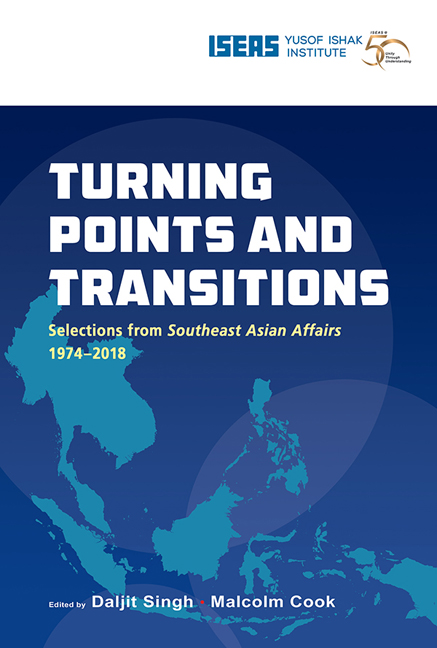Book contents
- Frontmatter
- Contents
- Message from the Director
- Foreword
- Foreword
- Introduction
- THE REGION
- The Diplomatic Emergence of China and Its Implications for Southeast Asia (1975*)
- Stability and Security in the Region after ANZUK (1975)
- The Question of the “Overseas Chinese” (1976)
- Southeast Asia 1976: The Handling of Contradictions (1977)
- The “Fukuda Doctrine” and Its Implications for Southeast Asia (1978)
- Expanding Horizons in Southeast Asia? (1994)
- AFTA in the Light of New Economic Developments (1995)
- The ASEAN Economic Miracle Unravels (1999)
- Southeast Asia in 1999: A False Dawn? (2000)
- East Timor's Future: Southeast Asian or South Pacific? (2001)
- Southeast Asia in 2002: From Bali to Iraq — Co-operating for Security (2003)
- The Year in ASEAN: The Charter, Trade Agreements, and the Global Economic Crisis (2010)
- Seeking Stability in Turbulent Times: Southeast Asia's New Normal? (2015)
- China's Two Silk Roads Initiative: What It Means for Southeast Asia (2015)
- China's International Strategy and Its Implications for Southeast Asia (2016)
- BRUNEI
- CAMBODIA
- INDONESIA
- LAOS
- MALAYSIA
- MYANMAR
- THE PHILIPPINES
- SINGAPORE
- THAILAND
- VIETNAM
The “Fukuda Doctrine” and Its Implications for Southeast Asia (1978)
from THE REGION
Published online by Cambridge University Press: 29 May 2019
- Frontmatter
- Contents
- Message from the Director
- Foreword
- Foreword
- Introduction
- THE REGION
- The Diplomatic Emergence of China and Its Implications for Southeast Asia (1975*)
- Stability and Security in the Region after ANZUK (1975)
- The Question of the “Overseas Chinese” (1976)
- Southeast Asia 1976: The Handling of Contradictions (1977)
- The “Fukuda Doctrine” and Its Implications for Southeast Asia (1978)
- Expanding Horizons in Southeast Asia? (1994)
- AFTA in the Light of New Economic Developments (1995)
- The ASEAN Economic Miracle Unravels (1999)
- Southeast Asia in 1999: A False Dawn? (2000)
- East Timor's Future: Southeast Asian or South Pacific? (2001)
- Southeast Asia in 2002: From Bali to Iraq — Co-operating for Security (2003)
- The Year in ASEAN: The Charter, Trade Agreements, and the Global Economic Crisis (2010)
- Seeking Stability in Turbulent Times: Southeast Asia's New Normal? (2015)
- China's Two Silk Roads Initiative: What It Means for Southeast Asia (2015)
- China's International Strategy and Its Implications for Southeast Asia (2016)
- BRUNEI
- CAMBODIA
- INDONESIA
- LAOS
- MALAYSIA
- MYANMAR
- THE PHILIPPINES
- SINGAPORE
- THAILAND
- VIETNAM
Summary
The “Fukuda Doctrine”
Manila was the last stop on Prime Minister Takeo Fukuda's tour of Southeast Asia. There, on 18 August, he delivered his noteworthy speech on Japan's policy towards that region. Japanese news media have billed the event as an epoch-making unveiling of what they call the “Fukuda Doctrine”, finding deep significance in the very fact that such a speech was made. While I would not go so far as to call the contents of the Manila address a “doctrine”, it is certainly the first time since the Second World War that a Japanese Prime Minister has made such a systematic presentation of views on relations with Southeast Asia.
The main points of the speech were as follows: first, Japan is committed to peace and to the role of an economic power; it will not become a military power. Secondly, as “an especially close friend” of ASEAN (Association of Southeast Asian Nations), Japan will co-operate in efforts to strengthen the solidarity of that organization. Thirdly, Japan will emphasize “heart-to-heart” contacts, building stronger ties as an equal partner not only economically, but in the social, political, and cultural realms as well. Fourthly, Japan will forge particularly close economic and trade relations with the countries of Southeast Asia and continue to deal with them in the context of the world economy. Fifthly, Japan will also attempt to foster relations based on mutual understanding with the nations of Indochina. Prime Minister Fukuda phrased these points as the “pillars” of Japan's Southeast Asian policy.
No doubt the real intentions behind the Prime Minister's speech will be interpreted variously as time goes on, but my immediate impression is that his approach came out of a compromise between an aggressive Japanese stance advocating active, full-scale involvement in Southeast Asia, and a passive view similar to the Meiji period's “dissociation from Asia” thesis, which holds that Japan must avoid deep involvement in that region. Be that as it may, the very fact that Japan should publicly announce any sort of a “doctrine” at all on this subject is fraught with significance.
Role of Japan and the U.S. in Southeast Asia
A broad historical background underlies these events; the force of its logic has pushed Japan into the stage centre of Asian regional politics, irrespective of the will of the Japanese people.
- Type
- Chapter
- Information
- Turning Points and TransitionsSelections from Southeast Asian Affairs 1974-2018, pp. 54 - 59Publisher: ISEAS–Yusof Ishak InstitutePrint publication year: 2018

